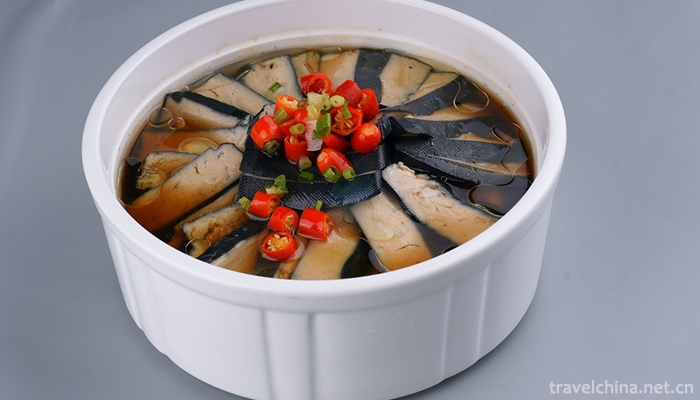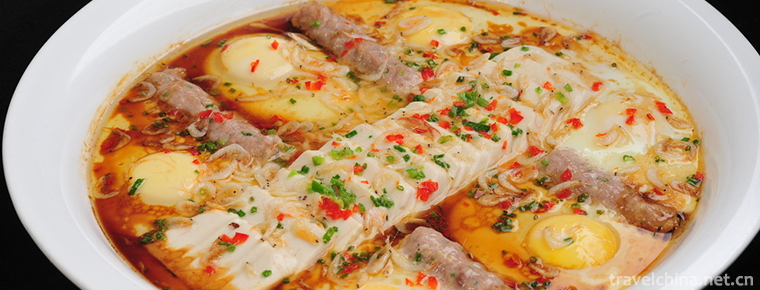Bagongshan bean curd
Bagongshan bean curd
Bagongshan Tofu, also known as Four Seasons Tofu, is a local traditional snack in Huainan City, Anhui Province. Bagongshan tofu is crystal clear, white like jade board, tender like congealed fat, delicate texture, refreshing and smooth, without yellowish pulp water taste, support is not fragmented. Chengdu cuisine is golden in color, crisp outside and tender inside, delicious in taste.
On September 17, 2008, the General Administration of Quality Supervision and Inspection (AQSIQ) approved it as a geographical indication product. In September 2018, it was rated as the top ten classic Anhui dishes of "Chinese cuisine".
Product characteristics
Nutritive value
Tofu is rich in nutrition and has the reputation of "vegetable meat". It contains not only many trace elements such as iron, calcium, phosphorus, magnesium and so on, but also sugar, vegetable oil and abundant high-quality protein. The digestive absorption rate of tofu is over 95%. Two pieces of tofu can meet a person's daily calcium requirement .
Characteristics of dishes
Bagongshan tofu is crystal clear, white like jade board, tender like congealed fat, delicate texture, refreshing and smooth, without yellowish pulp water taste, support is not fragmented. Chengdu cuisine is golden in color, crisp outside and tender inside, delicious in taste.
Main functions
Tofu is sweet and cool in nature. It enters the spleen, stomach and large intestine meridians. It has the functions of invigorating the spleen and replenishing qi, invigorating the spleen and dampness, clearing away heat and detoxification. It is very effective for deficiency of body, shortage of breath and food, insufficient milk secretion, kidney deficiency, urination or short and frequent urination, cloudy, pyretic fever, acne acne, dry throat, lung fever, cough, epigastric distention, dysentery and so on.
historical origin
In the Western Han Dynasty, it was said that Liu An, king of Huainan, used Bagongshan spring water, soybeans and brine to make elixirs for longevity. As a result, Xiandan was not available, but he inadvertently invented tofu, which was called "Bagongshan tofu".
Habitat environment
Bagongshan tofu originated in Huainan area of Anhui Province. It has a history of more than 2,000 years. The best quality of the tofu is in Bagongshan area of Huainan, which is called "Bagongshan tofu". This kind of tofu is made of pure soybean and refined with Bagongshan spring water. The local peasants'skill of making tofu has been handed down from generation to generation. Many people have mastered a good set of skills. The tofu made is fine, white, fresh and tender, and is very popular with the masses. According to the Compendium of Materia Medica written by Li Shizhen, a famous medical scientist in the Ming Dynasty, "The law of tofu began with Liu'an, the king of Huainan." Wang Ji of the Qing Dynasty said that the ancient books of the Western Han Dynasty had the record that Liu An made tofu. Liu An, the grandson of Liu Bang in Han Dynasty, was founded in Shouchun (now Shouxian County), where he recruited thousands of guests and scholars. Among them, Sufei, Li Shang, Tian You Leibei, Wubei, Jinchang, Mao Quilt and eight Zuo Wu people are known as "Eight Gong".
Production situation
There are more than 3000 soybean products processors in Bagongshan tofu Huainan City, and the output value reached more than 1 billion yuan in 2013. In 2015, the annual sales revenue of soybean products industry in Huainan will reach 3 billion yuan.
Honors
Time, honorary title/award, department/occasion
August 2008 National Geographic Indicators Products . AQSIQ
July 2014 Selected into the Fourth National List of Intangible Cultural Heritage . Ministry of Culture of the State Council
geographical indication
Protection Scope of Geographical Indicators of Bagongshan Tofu to the People's Government of Huainan City, Anhui Province
Letter on Defining the Protection Scope of Bagongshan Tofu Geographical Indications Products (No. 85 of Huaifu Secretariat ) and Letter of Shouxian People's Government on Defining the Protection Scope of Bagongshan Tofu Products Geographical Indications Products (No. Shou Zheng Secretary ).
Quality Technical Requirements
Bagongshan tofu, Huainan local standard; In 2007, Anhui Provincial Quality Supervision Bureau issued Bagongshan tofu, water tofu and skin, dried tofu, curd, 1000 pieces of provincial local standards. In 2008, "Bagongshan Tofu Anhui Provincial Standard" was issued.
Scope of geographical protection
Bagongshan tofu was awarded the title of geographical indication product in 2008. Its protection scope is as follows: Bagongshan District, Huainan City, Ancheng Town, Tianjiaan District, Liyongzi Town, Wangfenggang Street and Tangshan Town, Gaohuang Town, Pingwei Town, Tianji Street, Panji Town, Luji Town, Qiji Town, Gugou Hui Town and Jiahe Town, eight townships and eight townships in Shouxian County, Luan City. Shanxiang, Shouchun and Jiangou Towns are now under the jurisdiction of the three townships.
Use of special logo
Bagongshan tofu won the title of geographical indication product in 2008.




-
1.Meili Snow Mountain
Meili Snow Mountain, located in the eastern part of Chayu County, Tibet, and the western part of Jingyunling Township, Deqin County, Diqing Tibetan Autonomous Prefecture, Yunnan Province
Time 2018-11-13 -
2.Betelnut Valley Limiao Cultural Tourist Area
Hainan Betelnut Valley Limiao Cultural Tourist Area was established in 1998. It is located in the Ganshiling Nature Reserve at the junction of Baoting County and Sanya City
Time 2018-12-12 -
3.Zepkin Lake Yang National Forest Park
Zepujin Lake Poplar National Forest Park is located 36 kilometers southwest of Zepu County in Yasidun Forest Farm. It is located on the upper edge of the Yerqiang River alluvial fan
Time 2018-12-12 -
4.Shanghai Park Hyatt Hotel
Shanghai Park Hyatt Hotel is an exquisite modern Chinese-style residential hotel, located on the 79th to 93rd floors of Shanghai Global Financial Center, known as the Vertical Comprehensive Urban Area
Time 2018-12-16 -
5.Qilihai National Wetland Park
Qilihai National Wetland Park is located in the northeast of Tianjin, located in Ninghe District of Tianjin, 30 kilometers away from Tianjin urban area, 100 kilometers away from Beijing and 40 kilomet
Time 2018-12-17 -
6.Xingwen sea
Xingwenshihai is located in Xingwen County, Yibin City, Sichuan Province. It is located in the transition zone between Sichuan Basin and Yunnan-Guizhou Plateau. Its total area is about 156 square kilo
Time 2018-12-24 -
7.Zhalong Nature Reserve
Zhalong National Nature Reserve is the largest and world-famous Zhalong Wetland in China, located 30 kilometers southeast of Qiqihar City, Heilongjiang Province. With a total area of 210,000 hectares
Time 2019-01-13 -
8.Qingdao Yinhai International Yacht Club
Qingdao Yinhai International Yacht Club is located at No. 30 Donghai Middle Road, Qingdao City. It is the first national AAAA class tourist attraction in China with yacht club as its main body.
Time 2019-02-07 -
9.Zhangjiakou Zhangbei Grassland
Zhangbei grassland is located in Zhangbei County, 70 kilometers northwest of Zhangjiakou. It consists of two grasslands, Zhongdu and Angoli. In Zhangbei grassland, you can ride horses and shoot arrows
Time 2019-03-10 -
10.Two clip string
Two chords, also known as the "big five tones" by the masses. One of the traditional Chinese operas. It is mainly popular in Western Shandong, Eastern and Northern Henan,
Time 2019-04-28 -
11.Revenue and expenditure of Mianyang
In 2019, Mianyang's general public budget revenue will reach 13.115 billion yuan, an increase of 5.3%; general public budget expenditure will reach 45.334 billion yuan, an increase of 11.1%. The balance of RMB deposits in financial institutions was
Time 2020-12-14 -
12.Neijiang Sports
In 2019, Neijiang City will host 8 provincial and above sports competitions, 50 municipal sports meetings and 759 "happy weekend" activities; Neijiang sports athletes will win 3 gold medals, 4 silver medals and 6 bronze medals in international and domestic
Time 2020-12-16